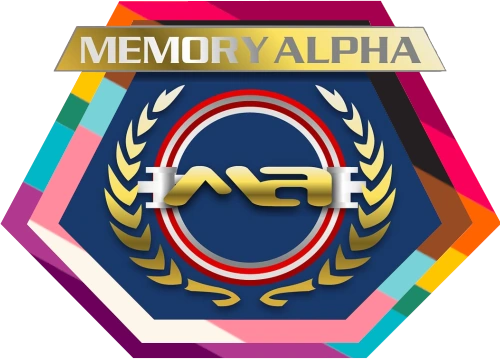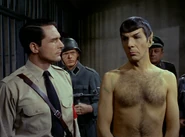"They are, they are – and damned annoying at times."
"Yes, sir."
The Vulcans, or Vulcanians,[1] were a warp-capablehumanoidspecies from the planetVulcan. They were widely renowned for their strict adherence to logic and reason as well as their remarkable stoicism.
In 2161, their homeworld became a founding member of the United Federation of Planets. (TOS: "Mudd's Women", "Amok Time"; TNG: "Encounter at Farpoint", "Data's Day", "Gambit, Part II"; Star Trek: First Contact; ENT: "Broken Bow", "Zero Hour", "Awakening", "These Are the Voyages...") Vulcans were known by the Borg as Species 3259. (VOY: "The Raven")
History and politics[]
- Main article: Vulcan history
In 2154, T'Pol stated that Vulcans had evolved on Vulcan. (ENT: "The Forge") Roughly a century later, however, Spock theorized that the Vulcans might be descendants of the Arretans. (TOS: "Return to Tomorrow") According to Narek, the myth of Ganmadan dated back to before the Romulan and Vulcan ancestors first arrived on Vulcan. (PIC: "Et in Arcadia Ego, Part 2") In 2369, evidence was discovered that several species including the Romulans, and therefore also the Vulcans, could be traced back to DNA that had been seeded on many planets by ancient humanoids4.5 billion years ago. (TNG: "The Chase")
The Vulcans were once an extremely violent and emotional people (even by Earth standards) who waged almost constant warfare on one another. (ENT: "Impulse", "Awakening"; TOS: "Balance of Terror", "Let That Be Your Last Battlefield"; VOY: "Random Thoughts"; SNW: "A Quality of Mercy") Paranoia and homicidal rage were common. (ENT: "Impulse") They believed in a variety of gods, such as war, peace, and death. (TNG: "Gambit, Part II") As their level of technology increased, the Vulcans eventually reached a point where their violent nature threatened the extinction of their own species. (ENT: "Awakening")
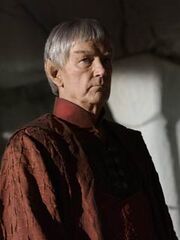
Surak, father of Vulcan logic
In an effort to avoid this fate, a Vulcan named Surak developed a new philosophy, thereby igniting the Time of Awakening. Surak maintained that the root cause of all the problems on Vulcan lay in the uncontrolled outpouring of the people's emotions. His followers swore to live their lives by an ethical system devised by Surak and based purely on logical principles. Emotions were to be controlled and repressed. (TAS: "Yesteryear")
Although this new philosophy spread rapidly across Vulcan, a minority, many of whom were known as "those who march beneath the raptor's wings", rejected Surak's ideals. A destructive war began, including the use of atomic bombs, and among the victims was Surak himself. (ENT: "The Forge", "Awakening")
Eventually, however, those who opposed logic left Vulcan and founded colonies elsewhere (TNG: "Gambit, Part I", "Gambit, Part II") – most notably on the planet Romulus, where they founded what eventually became the Romulan Star Empire. (TOS: "Balance of Terror", "The Enterprise Incident"; TNG: "Unification I", "Unification II") At some point in history, the Romulans and the Vulcans engaged in a hundred-year-long war against one another. The war was instigated by the actions of a member of the Q Continuum. (VOY: "Death Wish")
Another group that rejected Surak's philosophy was known as the "V'tosh ka'tur", or "Vulcans without logic". The V'tosh ka'tur believed in controlling emotions by allowing themselves to actively experience them rather than suppressing them. Some of these also left Vulcan, and took up a nomadic existence. (ENT: "Fusion") Many turned to crime, however, and subsequently sent for rehabilitation at facilities such as the Ankeshtan K'til Retreat. (SNW: "Spock Amok", "The Serene Squall") A prime example of a V'tosh ka'tur was Sybok, who underwent failed rehabilitation at Ankeshtan K'Til for involvement in piracy before ultimately trying to use emotion rather than logic to find answers to the creation of the universe. (SNW: "The Serene Squall"; Star Trek V: The Final Frontier)

First contact with Humans in 2063
The Vulcans conducted a series of survey missions to the Sol system, as early as 1957. (ENT: "Carbon Creek") Vulcans were, in fact, one of the first species to develop warp drive, though a century passed between the first warp flight and the breaking of the warp 2 barrier. (ENT: "First Flight") T'Pol told Archer that Vulcans "don't share" Humans' "enthusiasm for space exploration," but a Syrrannite on Vulcan later advised Archer that this may not have been true. (ENT: "Fight or Flight", "The Forge")
The official First Contact between Vulcans and Humans came on April 5, 2063, when a Vulcan survey ship, the T'Plana-Hath, detected the warp flight of Zefram Cochrane's Phoenix. The Vulcans met with Cochrane at his launch site on the day following the flight. (Star Trek: First Contact)
Subsequently, the Vulcans offered their technological guidance to Humans, but were criticized on Earth for holding back their development. (ENT: "First Flight", "Broken Bow") A century after First Contact, the High Command had become worried about Humans, who, like Vulcans, had had devastating wars, but after which had rebuilt and started traveling to the stars much faster. There were those on the High Command who wondered what Humans would achieve in the century to come, and did not like the answer. (ENT: "The Forge")
By the mid-22nd century, Vulcan culture had strayed from the path that Surak had originally laid out for them, to the point that Surak's katra did not recognize it as the culture he had helped to create. They had ceased being explorers and the High Command, once devoted to that goal, had instead become involved in a conflict with the neighboring Andorians. (ENT: "Awakening", "The Forge")
The Vulcan High Command used an ancientmonastery at P'Jem as a secret listening post to spy on the Andorians until June2151, when the listening post was discovered by the Andorians and a landing party from Enterprise NX-01. Later, the Humans helped negotiate a peace between the Vulcans and Andorians over a disputed class Dplanetoid known to the Vulcans as Paan Mokar. (ENT: "The Forge", "The Andorian Incident", "Cease Fire")
Vulcans also became less tolerant of political and philosophical challenges towards the High Command's operations, notably engaging in purges of the Syrrannite group, who claimed that Vulcan society was no longer following the teachings of Surak. These tensions came to a head in a crisis called the Vulcan Reformation, which resulted in the overthrow of the High Command (and its leader, V'Las, who was secretly allied with the Romulans), as well as a restructuring of the Vulcan government including the dissolution of the High Command. T'Pau became a minister in this government. A less aggressive policy towards Earth was also adopted. (ENT: "The Forge", "Awakening", "Kir'Shara", "United")
Berman explained that they wanted their Human characters from a hundred years before Kirk to seem unsure of themselves as they began space exploration, and Braga added they wanted to also "revamp the Vulcans a little bit and show that they evolved as well."
From a separate resource, Manny Coto said in an interview that he had planned to do several three-episode arcs in the 4th year of ENT, and among them he had developed a story about how the Vulcans had "floundered from the original teachings of Surak", but then made their way back. He felt the story deserved to be an epic, but he didn't want it to be a season-long arc. Thus the three-episode Vulcan arc that appeared on ENT. (See Coto's interview in The Fifty-Year Mission: The Next 25 Years from the Next Generation to J.J. Abrams (2016), by Mark A. Altman and Edward Gross, pp. 721-722.)
By the 21st and 22nd centuries, the Vulcans had also made contact with the Cardassians, Trill, Tholians, Klingons (as early as 2016), and scores of other races. (DS9: "Destiny"; ENT: "Broken Bow", "Future Tense")
As of the 23rd century, Vulcan had never been conquered in its collective memory. That memory went so far back that Vulcans could not conceive of a conqueror. (TOS: "The Immunity Syndrome")
By the 24th century, Vulcan remained one of the principal Federation members, and was deeply involved at all levels of that society. Vulcans were present in the Federation colonies found within the Demilitarized Zone established between the United Federation of Planets and the Cardassian Union by the terms of the Federation-Cardassian Treaty of 2370; they were among the colonists' representatives during discussions with the Cardassians concerning terrorist attacks by the anti-Cardassian Maquis movement established in the Zone. At least one Vulcan, Sakonna, acted as a gun runner and interrogator for the Maquis and made use of her people's ability to mind meld in the latter role. (DS9: "The Maquis, Part I", "The Maquis, Part II")
The Vulcans' tradition of exploration continued; in the 24th century, a Vulcan ship was the first to make formal contact with a Gamma Quadrant civilization, upon encountering the Wadi. (DS9: "Move Along Home") The Vulcans were at the forefront of exploration in the Gamma Quadrant, encountering the Rakhari and finding the remains of the Hur'q civilization. (DS9: "Vortex", "The Sword of Kahless") In the 24th century, the Vulcan ministry of security was known as the V'Shar. (TNG: "Gambit, Part II")
By 2369, the Vulcans had a saying known to the Federation: "We're here to serve." (DS9: "Captive Pursuit")
Despite the enmity between the Federation and the Romulan Star Empire, some Vulcans attempted to forge a more cordial relationship with their cousins, ultimately hoping to reunify the two cultures. Many of these efforts met with little success. (TNG: "Unification I", "Unification II")
Mirror universe[]
History turned out much differently for the Vulcans of the mirror universe. When the Vulcans made first contact with Earth of this universe in 2063, Zefram Cochrane shot the first Vulcan to publicly set foot on Terran soil, believing his vessel to be the vanguard of an intended invasion. The Terrans stormed the T'Plana-Hath and studied Vulcan technology. Eventually, the Vulcans were conquered by the Terran Empire. (ENT: "In a Mirror, Darkly"; DIS: "Die Trying")
By the 2150s, Vulcans were considered slaves to Terrans and not treated as equals. Vulcans later participated in a rebellion against the Empire in the 2250s. By 2267, the half-Vulcan Spock had become first officer of a starship and eventually rose to the top of the Terran Empire itself. After the Empire was conquered by the Klingon-Cardassian Alliance, Vulcans served as slaves to the Klingon-Cardassian Alliance. Using fans, several of them cooled the Intendant aboard Terok Nor. (ENT: "In a Mirror, Darkly, Part II"; TOS: "Mirror, Mirror"; DS9: "Crossover")
Some Vulcans, such as Tuvok, joined the Terran Rebellion. (DS9: "Through the Looking Glass")
Alternate reality[]
In the alternate reality, the planet Vulcan was destroyed by a Romulan named Nero in 2258. Over six billion Vulcans were killed, with an estimated ten thousand survivors. After witnessing the atrocity, Spock noted in his log that the Vulcan species had become endangered. (Star Trek) Spock's prime reality counterpart founded a colony for the survivors, which, by the following year, had been settled and named New Vulcan. (Star Trek Into Darkness)
Physiology[]
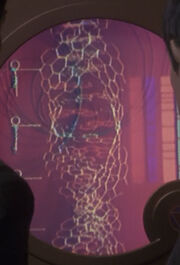
Scan of a Vulcan's DNA
Species which shared some physiological and behavioral traits with Vulcans were categorized as Proto-Vulcan humanoids. One example of this were the Mintakans. (TNG: "Who Watches The Watchers") In addition, Rigelianphysiology was very similar to that of Vulcans. (TOS: "Journey to Babel")
Vulcans were generally similar to Humans in appearance, distinguished mainly by their pointed ears and upswept eyebrows. Their skin color was most commonly pale with a bronze or greenish tint, though some had brown skin. Vulcan physiognomy could resemble Humans of European, Asian, or African descent. (Star Trek: The Original Series; Star Trek III: The Search for Spock; Star Trek: Voyager)
Most Vulcans had straight, glossy black hair, though brown and/or curly hair was also possible. Vulcans had body hair similar to Humans, and some males could be very hirsute. Vulcan males were capable of growing facial hair, but most chose to shave it. (TOS: "Mirror, Mirror", "Patterns of Force"; Star Trek V: The Final Frontier; VOY: "Year of Hell"; ENT: "In a Mirror, Darkly, Part II"; Star Trek)
Vulcan teeth included anterior tricuspids, which could be protected from decay for decades by sealing them with a trifluorinate compound. (ENT: "Dear Doctor")
In contrast to their external similarities, Vulcan internal anatomy differed radically from that of Humans. For instance, their heart was where a Human's liver would normally be, (TOS: "Mudd's Women", "A Private Little War", "The Omega Glory"; Star Trek Beyond) and beat several hundred times per minute. (TOS: "The Naked Time", "Journey to Babel") Vulcans also had no appendix. (TOS: "Operation -- Annihilate!") They did, however, have mitochondria. (TNG: "Data's Day")

A greenish bruise
Vulcan blood was copper-based and was copper- or rust-colored when deoxygenated in the veins and green when oxygenated, in the arteries, or when bleeding. Bruises and dermal abrasions took on a greenish color. (TOS: "The Naked Time", "Obsession", "Patterns of Force"; DS9: "Field of Fire"; VOY: "Repression"; ENT: "Shadows of P'Jem", "In a Mirror, Darkly, Part II")
Vulcan body chemistry used little, if any, sodium chloride compared to that of Humans. (TOS: "The Man Trap")
Vulcans possessed a highly efficient respiratory system to extract the oxygen they needed from Vulcan's thin atmosphere. They were most comfortable in high temperatures. A Vulcan of advanced age could become more sensitive to lower temperatures. (TOS: "The Deadly Years"; ENT: "The Forge")
The Vulcan digestive tract was highly adaptable. Although alienfoods, notably Human food, would occasionally disagree with a Vulcan, given time, their body could adapt to the alien food. (ENT: "Unexpected")
Vulcan hearing was very sensitive. (TOS: "Return to Tomorrow", "The Way to Eden"; ENT: "Singularity") Vulcan females possessed a heightened sense of smell. T'Pol used a regularly injected nasal numbing agent to suppress the smell of Humans. (ENT: "Broken Bow", "The Andorian Incident") By the 24th century, where regrowing body parts was easier, those on missions can opt for cauterization of scent receptors by a doctor. (LD: "Fully Dilated")
Having evolved on a planet which was mostly desert, Vulcans developed ways of surviving in desert conditions. For example, they could survive for several days without water and had inner eyelids which protected their eyes. (TOS: "Operation -- Annihilate!"; ENT: "Strange New World", "The Forge")
Vulcans had a superior metabolism to Humans. Caffeine and saponins had little effect on them, (ENT: "Breaking the Ice") and they were also far less vulnerable to the effects of tropolisine. (ENT: "Strange New World") Vulcans were also capable of surviving for long durations without food or sleep. Under stress, Vulcans could do without sleep for weeks. (TOS: "The Paradise Syndrome") Tuvok once claimed that, as a Vulcan, he was capable of going without sleep for two weeks, although, shortly after making this claim, he fell asleep in the command chair after having gone a little over ten days without sleep. (VOY: "Muse")
Vulcans were, on average, three times physically stronger than Humans, and had considerably faster reflexes. (DS9: "Take Me Out to the Holosuite")
Vulcans were very sensitive to nitrous oxidegas, which rapidly rendered them unconscious. (TAS: "The Practical Joker")
Vulcans typically had a lifespan of two hundred years or more. Their aging was correspondingly slower; a Vulcan of age 65 had the appearance of a 20th century Human in their late 20s, and was considered in their "quarter-life". (ENT: "Broken Bow", "Zero Hour"; TNG: "Sarek"; LD: "Empathological Fallacies")
Brain[]
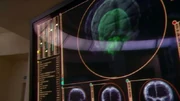
A medical scan of Soval's brain

A medical scan of Spock's brain
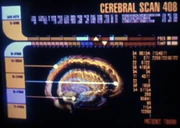
A medical scan of Tuvok's brain
Perhaps the most interesting aspect of the Vulcan physiology was the brain. The Vulcan brain was described by The Doctor as "a puzzle, wrapped inside an enigma, housed inside a cranium." (VOY: "Riddles") Indeed, The Doctor has also noted how "the Vulcan brain never ceases to amaze me." (VOY: "Blood Fever")
A Vulcan's brain was in direct control of most of the bodily functions, acting as a control unit for many organs. Despite this, a Vulcan body from which the brain had been removed was capable of functioning and even walking around (albeit in a zombie-like state) with a portable life support system. (TOS: "Spock's Brain")
Unlike most humanoid species, traumatic memories were not only psychologically disturbing to Vulcans, but had physical consequences as well. The Vulcan brain, in reordering neural pathways, could literally lobotomize itself. (VOY: "Flashback")
Vulcans learned to gain conscious control of many of these functions, allowing them to regulate their bodies to a high degree by simple will-power. When injured, a Vulcan could go into a trance-like state, using this ability to concentrate all of his or her energy on repairing the injury. (TOS: "A Private Little War") However, Vulcans did have certain levels of pain they were unable to suppress, forcing them to endure the experience. (VOY: "Resistance")
This trance could be self-induced and gave the physical appearance of near-death. It was similar, in principle, to Vulcan neuro-pressure techniques which could be used to relax the mind and body. (TOS: "By Any Other Name"; VOY: "Riddles"; ENT: "The Xindi")
The substance trellium-D acted as a neurotoxin to Vulcans, destroying the neural pathways which controlled their emotions. Treatment had to be provided quickly after exposure; otherwise, the damage was irreversible. (ENT: "Impulse")
The most famous aspect of the Vulcan brain were the inherent telepathic abilities, such as the mind meld. Vulcans were natural touch-telepaths. Though considerable training was required to utilize this ability to the fullest (like performing the fal-tor-pan), simpler contacts did not require any concentration, training, or even conscious knowledge of the act. (VOY: "Blood Fever")
Vulcans called focal points in the bioelectric field of the brain qui'lari. (DS9: "The Muse")
Stronger minds were capable of non-contact telepathic projection and scanning, usually over short distances, (TOS: "The Devil in the Dark", "The Omega Glory"; VOY: "Random Thoughts", "Prey") but sometimes even over interstellar distances. (TOS: "The Immunity Syndrome"; Star Trek: The Motion Picture; DIS: "Lethe" )
Another psionic ability of the Vulcan race was the telepathic suggestion or compulsion, consciously performed by Spock, (TOS: "Dagger of the Mind", "A Taste of Armageddon", "The Omega Glory") Sybok, (Star Trek V: The Final Frontier) Tuvok, (VOY: "Repression") and T'Pol, (ENT: "In a Mirror, Darkly") and unconsciously performed by Sarek. (TNG: "Sarek")
Although Vulcans did not, typically, allow themselves to experience uncontrolled strong emotions, they could sense them in others. (ENT: "Fallen Hero")
Vulcans were capable of performing a synaptic pattern displacement, or the transfer of one individual's consciousness into another. (Star Trek III: The Search for Spock; DS9: "The Passenger")
The psycho-suppression system responsible for the Vulcan suppression of emotions was located in the mesiofrontal cortex. (VOY: "Meld")
Approximately every seven years, adult Vulcans had to endure pon farr, the Vulcan mating period. It was marked by intense emotions and primal urges (known as plak tow, or "blood fever") that could kill the Vulcan if not satisfied. Physiological symptoms included elevated dopamine levels and fever. For such an orderly society of quiet sobriety, the madness which accompanied the outbreak of pon farr was an unavoidable evil. (ENT: "Bounty", "In a Mirror, Darkly"; TOS: "Amok Time"; VOY: "Blood Fever")
Medical conditions[]
There were several diseases from which the Vulcan species suffered, including:
Hybridization[]
Vulcans and Humans could not reproduce without medical intervention according to 2150s medical knowledge. (ENT: "E²", "Demons", "Terra Prime")
In 2155, Terra Prime extremists created a binary clone from T'Pol and Trip Tucker. The child, whom they called Elizabeth, had many genetic flaws due to the method of her creation and she died. (ENT: "Demons", "Terra Prime")
In 2230, Spock was born on Vulcan to Sarek and Amanda Grayson. (ENT: "Terra Prime"; TOS: "Journey to Babel", "The Squire of Gothos"; Star Trek Beyond)
The Vulcan heritage in Vulcan-Human hybrids was dominant, with copper-based blood, pointed ears, and the full range of Vulcan abilities.
Society and culture[]

IDIC, the Vulcan national symbol
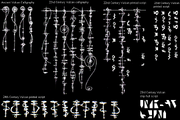
Six different Vulcan scripts
Vulcans were generally non-violent, but logic dictated that combat was sometimes necessary. Vulcans could and did use weapons and practiced martial arts called tal-shaya and Suus Mahna. (TOS: "Journey to Babel"; ENT: "Marauders"; DIS: "Context Is for Kings")
Vulcans considered death to be the completion of a journey. Therefore, they did not fear it happening; however, the loss of one's katra was to be avoided if possible, since the katra lived on beyond the physical death. (Star Trek III: The Search for Spock) They also practiced euthanasia for the infirm and elderly, and saw nothing wrong with practicing ritual suicide when they reached a certain infirmity with age. (VOY: "Death Wish") As they knew death was an inevitability, they believed that fear of death was ultimately illogical. (Star Trek Beyond)
The government on Vulcan was a representative democracy. Individual political advancement was based on meritocratic principles. (ENT: "Awakening")
Although Vulcans were highly integrated into the Federation, in the 23rd century, some Vulcans viewed service in Starfleet to be less prestigious than attending the Vulcan Science Academy, (TOS: "Journey to Babel") though in the twilight years of that century, this apparently became much less of an issue. (VOY: "Flashback") Furthermore, among all the Federation members whose people served in Starfleet, Vulcans were the only ones to be accommodated with starships crewed entirely by their own species, such as the USS Intrepid and the USS T'Kumbra. (TOS: "The Immunity Syndrome"; DS9: "Take Me Out to the Holosuite")
Vulcans played a game known as kal-toh. (VOY: "Alter Ego", "The Omega Directive", "Endgame")
Vulcans had a traditional funeral dirge. (VOY: "Tuvix")
Vulcans occasionally gave gifts. However, Vulcan custom did not include receiving a gift back from a recipient. (Star Trek Beyond)
Naming[]
Vulcans possessed family names, although they were pronounceable by Humans only after many years of practice. (TOS: "This Side of Paradise", "Journey to Babel")
Many Vulcan females had names beginning with "T'" and particularly "T'P" (T'Pol, T'Pring, T'Pau, T'Mir, T'Pel, T'Pan), but not all (Valeris, Sakonna, Saavik, Selar); many males had names beginning with "S" (Spock, Sarek, Sybok, Surak, Stonn, Soval); again, though, there was variation (Tuvok, Lojal, Vorik, Taurik, Koss).
Education[]
Naturally, the development of a Vulcan's lifelong devotion towards logic was encouraged at a very early age. Vulcan parents utilized careful and gentle methods to train their infants in primary logic. (VOY: "Human Error") Vulcan children learned, by example, how to detach themselves from their emotions as well, and it often aided in difficult childhood situations. (ENT: "Fusion", "Home"; TAS: "Yesteryear"; VOY: "Innocence", "Gravity") Despite logic being paramount in education, Vulcan children were allowed much freedom as well, and enjoyed a number of passions their controlled states allowed them to coordinate.
As parents, Vulcans never restricted their children from real life. Doing so only hindered their ability to develop their own identity. A Vulcan parent's attachment to their children could not be described as an emotion. They were part of the parent's identity and the parent was incomplete without them. (VOY: "Innocence")
Children at Vulcan nursery schools danced. (TOS: "Whom Gods Destroy")
When they were older, they learned in skill domes. The Vulcan Learning Center employed these. (Star Trek, DIS: "The Vulcan Hello", "Battle at the Binary Stars")
A Vulcan program suitable for young children which taught basic problem solving skills was available at Deep Space 9's school in 2370. (DS9: "Whispers")
The Vulcan Science Academy and Vulcan Medical Institute were two notable post-secondary institutions.
Logic and emotions[]
Contrary to stereotype, Vulcans possess strong emotions. They use meditation as a way to suppress those emotions. For instance, emotions like remorse, relief, joy, and embarrassment were all displayed by Spock when he thought Captain Kirk was dead and then saw him alive. (TOS: "Amok Time"). Indeed, Vulcan emotions were far more intense, violent, and passionate than those of many other species, including even Humans. (TNG: "Sarek")
It was this passionate, explosive emotionality that Vulcans blamed for the vicious cycle of wars which nearly devastated their planet. As such, they focused their mental energies on mastering them. The essence of their logical society was in arriving at the truth through logical process. Emotions were illogical, thus making them impure, and deterrent to truth. Vulcans were born with the same emotions that afflicted their violent ancestors, but continual mental conditioning generally gave them the impassivity they sought. (TAS: "Yesteryear")
Though not all could arrive at the ultimate pure logical state, the exacting process of mental control gave Vulcans enough to conform to the ideals of Vulcan society. The ultimate level of logical thought was achieved through the attainment of kolinahr, which was said to purge them of all remaining emotions. (Star Trek: The Motion Picture)
Attitudes to deception[]
Vulcans were renowned for their honesty, and indeed it has been claimed that "Vulcans could notlie." However, they would do so for what they perceived as logical reasons, though they rarely referred to their dishonesty as "lying." (TOS: "The Enterprise Incident"; Star Trek II: The Wrath of Khan; Star Trek VI: The Undiscovered Country) For instance, an elder denied the existence of technology and spies at the monastery at P'Jem in order to protect an ongoing surveillance operation. (ENT: "The Andorian Incident"). Also, T'Pol's second foremother directly lied to another Vulcan, telling the commander of a rescue party that her crewmate had died in a crash, so that he could remain on Earth to "study" Humanity. (ENT: "Carbon Creek")
In 2259 of the alternate reality, Spock managed to deceive Khan Noonien Singh into transporting armed torpedoes aboard the USS Vengeance, as Khan believed they still carried members of his crew. Khan wasn't aware that Spock had anticipated his betrayal and removed Khan's crew from the torpedoes with the intent to detonate them and cripple the Vengeance. When Khan stated that he'd know if they weren't his, Spock assured him that "Vulcans do not lie" and that "the torpedoes were his". This demonstrated that Vulcans, while still technically telling the truth, didn't always necessarily tell the entire truth if it was to their advantage. (Star Trek Into Darkness)
Tuvok at one point stated, when responding to Seven of Nine questioning him as to whether Vulcans were capable of lying "we are capable of telling lies. However, I have never found it prudent or necessary to do so." (VOY: "Hunters")
T'Rina, the President of Ni'Var as the Vulcan homeworld was renamed by the 32nd century, showed a willingness to lie in 3191, engaging in an elaborate deception to PrimarchRuhn of the Breen Imperium while negotiating with him. (DIS: "Erigah")
Spirituality[]
- See also: Vulcan mythology
The Vulcans held a number of spiritual beliefs. Their religious system was polytheistic. They also believed in the katra, the soul and consciousness of a person, which could be transferred psionically prior to death. (TAS: "Yesteryear"; Star Trek II: The Wrath of Khan; Star Trek III: The Search for Spock; TNG: "Gambit, Part I"; ENT: "The Forge", "Awakening")
Meditation was a central component of Vulcan life. The Vulcan Sh'vhal type ship of the late 24th century was known to feature a dedicated meditation chamber that the crew could use alone or in small groups. (LD: "wej Duj")
What little is known about Vulcan religious beliefs indicates that, beginning prior to the "Time of the Awakening", they were polytheistic. Surak's teachings became the primary focus of Vulcan spirituality/mysticism, but, as late as the 23rd century, it was still not unheard of to find Vulcans honoring the traditional gods. There were, however, no demons in Vulcan literature. (TAS: "Yesteryear"; TNG: "Gambit, Part I"; VOY: "Heroes and Demons")
Romantic relationships[]
- See also: Vulcan mating rituals
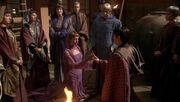
Vulcan wedding ceremony

Vulcan ceremonial wedding grounds, circa 2260s
When Vulcan children came of age, having sometimes been betrothed to childhood companions by age seven, underwent the pon farr, the link compelled them to follow through with full marital rituals, which cemented their relationship. (TOS: "Amok Time"; ENT: "Breaking the Ice")
It was traditional for the female to propose marriage by presenting a necklace to the male. She may signal her intention to do so by wearing ritual mating colors on an auspicious date, such as the anniversary of a first courtship event. (SNW: "Strange New Worlds")
If, for whatever reason, the female did not wish to go through with the marriage, then the ceremony of koon-ut-kal-if-fee ("marriage or challenge") was invoked. The male fought for the right to keep his mate against a challenger of her choosing. The female became the property of the male who won the contest, unless he chose to release her. The koon-ut-kal-if-fee was a fight to the death. (TOS: "Amok Time")
As of 2266, hearsay held that Vulcan men treated their women strangely. (TOS: "The Naked Time")
According to Spock, it was "undignified for a woman to play servant to a man that is not hers" as his reason for throwing food (from Nurse Chapel) against the wall. (TOS: "Amok Time") Yet, a century earlier, T'Pol brought Jonathan Archer food and blankets in sickbay, and in an alternate timeline, tended to him as a nursemaid (ENT: "A Night in Sickbay", "Twilight").

Vulcan wedding ceremony, ca 2260s
Touching each other with both the middle- and the forefinger was a custom practiced by married couples and was part of the Vulcan marriage ceremony. (TOS: "Journey to Babel"; VOY: "Bliss"; ENT: "Home") It could also help to calm down male Vulcans during pon farr. (Star Trek III: The Search for Spock)
Food and drink[]
Most Vulcans were primarily vegetarians. They also did not touch food with their hands unless wearing special gloves. (ENT: "Broken Bow", "Home") The v'tosh ka'tur were a major exception to these rules, however. (ENT: "Fusion")
Vulcans were fermenting wines, notably Vulcan port, during the 21st century. (DS9: "The Maquis, Part I")
Guests in a Vulcan household were expected to rise before sunrise to prepare the morning meal. (ENT: "Home") Plomeek broth was considered a traditional Vulcan breakfast. (ENT: "Unexpected")
Holidays[]
See also[]
Science and technology[]
Individuals[]
Appendices[]
Appearances[]
A list of all appearances of Vulcans (excluding the regular appearances of Spock, Tuvok, T'Pol, and Maj'el):
- TOS:
- "Amok Time" (Season Two)
- "Mirror, Mirror"
- "Journey to Babel"
- "The Savage Curtain" (Excalbian recreation only) (Season Three)
- TAS:
- "Yesteryear" (Season One)
- "The Time Trap"
- TOS films:
- TNG:
- "Encounter at Farpoint" (Season One)
- "The Last Outpost"
- "Coming of Age"
- "Symbiosis"
- "Conspiracy"
- "The Outrageous Okona" (Season Two)
- "The Schizoid Man"
- "A Matter Of Honor"
- "The Dauphin"
- "Shades of Gray" (footage from "The Dauphin")
- "The Ensigns of Command" (Season Three)
- "Yesterday's Enterprise"
- "Captain's Holiday"
- "Sarek"
- "Ménage à Troi"
- "Qpid" (Season Four)
- "Ensign Ro" (Season Five)
- "Unification II"
- "Unification I"
- "The First Duty"
- "Imaginary Friend"
- "Suspicions" (Season Six)
- "Gambit, Part I" (Season Seven)
- "Gambit, Part II"
- "Lower Decks"
- "Preemptive Strike"
- TNG films:
- DS9:
- "Emissary" (Season One)
- "The Nagus"
- "Vortex"
- "The Forsaken"
- "The Maquis, Part I" (Season Two)
- "The Maquis, Part II"
- "Crossover"
- "Through the Looking Glass" (Season Three)
- "Shakaar"
- "The Visitor" (Season Four)
- "Homefront"
- "Bar Association"
- "Rules of Engagement"
- "Shattered Mirror"
- "For the Cause"
- "Broken Link"
- "Trials and Tribble-ations" (Season Five)
- "Rapture"
- "Behind the Lines" (Season Six)
- "Favor the Bold"
- "Valiant"
- "Image in the Sand" (Season Seven)
- "Afterimage"
- "Take Me Out to the Holosuite"
- "Prodigal Daughter"
- "The Emperor's New Cloak"
- "Field of Fire"
- VOY:
- "Caretaker" (Season One)
- "Persistence of Vision" (illusion only) (Season Two)
- "Alter Ego" (Season Three)
- "Fair Trade"
- "Blood Fever"
- "Darkling" (hologram only)
- "Day of Honor" (Season Four)
- "Demon"
- "Extreme Risk" (Season Five)
- "In the Flesh" (Species 8472 posing as Vulcan)
- "Counterpoint"
- "Gravity"
- "Bliss" (illusion only)
- "Repression" (Season Seven)
- "Flesh and Blood" (hologram only)
- "Body and Soul" (hologram only)
- "Renaissance Man"
- "Endgame"
- ENT:
- "Broken Bow" (Season One)
- "The Andorian Incident"
- "Breaking the Ice"
- "Shadows of P'Jem"
- "Fusion"
- "Fallen Hero"
- "Carbon Creek" (Season Two)
- "Shockwave, Part II"
- "Dead Stop"
- "The Seventh"
- "Stigma"
- "Cease Fire"
- "First Flight"
- "The Expanse"
- "Impulse" (Season Three)
- "Twilight"
- "E²"
- "Home" (Season Four)
- "The Forge"
- "Awakening"
- "Kir'Shara"
- "In a Mirror, Darkly"
- "In a Mirror, Darkly, Part II"
- "Terra Prime"
- DIS:
- "The Vulcan Hello" (Season One)
- "Battle at the Binary Stars"
- "Choose Your Pain"
- "Lethe"
- "Si Vis Pacem, Para Bellum"
- "Into the Forest I Go"
- "The Wolf Inside"
- "The War Without, The War Within"
- "Will You Take My Hand?"
- "Brother" (Season Two)
- "Light and Shadows"
- "If Memory Serves"
- "Project Daedalus"
- "The Red Angel"
- "Perpetual Infinity"
- "Through the Valley of Shadows"
- "Such Sweet Sorrow"
- "Such Sweet Sorrow, Part 2"
- "Unification III" (Season Three)
- "That Hope Is You, Part 2"
- "Anomaly (DIS)" (Season Four)
- "Choose to Live"
- "All Is Possible"
- "...But to Connect"
- "Rubicon"
- "The Galactic Barrier"
- "Rosetta"
- "Species Ten-C"
- "Coming Home"
- ST:
- "Q&A" (Season Two)
- PIC:
- "Maps and Legends" (Season One)
- "The End is the Beginning"
- "Nepenthe"
- "Broken Pieces"
- "Et in Arcadia Ego, Part 1"
- "Et in Arcadia Ego, Part 2"
- "The Star Gazer" (Season Two)
- "Mercy"
- "Farewell"
- "The Next Generation" (Season Three)
- "Disengage"
- "Seventeen Seconds"
- "No Win Scenario"
- "Imposters"
- "Dominion"
- "Surrender"
- "The Last Generation"
- LD:
- "Second Contact" (Season One)
- "Much Ado About Boimler"
- "Veritas"
- "Kayshon, His Eyes Open" (Season Two)
- "Mugato, Gumato"
- "An Embarrassment Of Dooplers"
- "wej Duj"
- "First First Contact"
- "The Least Dangerous Game" (Season Three)
- "Hear All, Trust Nothing"
- "The Stars At Night"
- "Twovix" (Season Four)
- "In the Cradle of Vexilon"
- "Something Borrowed, Something Green"
- "Empathological Fallacies"
- "A Few Badgeys More"
- "Caves"
- "The Inner Fight"
- "Old Friends, New Planets"
- PRO:
- "Kobayashi" (hologram) (Season One)
- "Supernova, Part 2"
- SNW:
- "Strange New Worlds" (Season One)
- "Spock Amok"
- "The Serene Squall"
- "Ad Astra per Aspera" (Season Two)
- "Charades"
- "Under the Cloak of War"
Background information[]
The Vulcans were the first alienspecies created for Star Trek by Gene Roddenberry. ("The Andorian Incident", text commentary, ENT Season 1 DVD special feature)
^ The term "Vulcanian" has been described as an "Obsolete term meaning a native of the planet Vulcan. The term 'Vulcan' has come to mean both the planet and the native of same." (Star Trek Concordance, p. 248) The origin of the term from a production standpoint dates to 1966, when NBC prepared a twelve-page booklet, entitled "Advance Information on 1966-67 Programming: Star Trek", which described the series' regular crewmembers. The description of Spock mentions that his father was a native of "Vulcanis," and his people were known as the "Vulcanians". (The Star Trek Compendium, p. 25) As a result of early "growing pains" in the writing staff, the term "Vulcanian" was used sporadically (and sometimes interchangeably) during the first season, where it was heard in "Mudd's Women", "Court Martial", "A Taste of Armageddon", "This Side of Paradise", and "Errand of Mercy". The Bajorans suffered similar "growing pains" when they were briefly known as the "Bajora" during their early appearances. The name "Vulcan" itself, in reference to the people, was first heard in "The Naked Time". See also:Vulcanian expedition and Vulcanian Scientific Legion of Honor.
In notes that Costume Designer Robert Fletcher wrote about the various aliens in the filmStar Trek: The Motion Picture, he included a description of the Vulcans. After pointing out the Vulcans were "from tv series", the brief continued as follows:
"Observed in the movie as Mr. Spock, others among crew, and the Masters on Vulcan planet scene. Unemotional, scientific people, their culture based on cold logic, reason and control. One of the Federation's most advanced races [....] Vulcans are mostly tall, slender, beautiful people, with strong sense of honor. Physically distinguished by upswept eyebrows and pointed ears. Their green blood is copper-based."
Fletcher also imagined that, because their homeworld was rich in jade, the Vulcans made extensive use of that substance, such as with ruby jewellery and a red-colored giant statue is visible on the planet's surface, in the film. (The Making of Star Trek: The Motion Picture, p. 133)
The depiction of Vulcans developed with the introduction of Tuvok on Star Trek: Voyager, as he was the first black Vulcan main character. In developing the character of Tuvok, the series' creators tried to put a new spin on the long-established alien species. However, Executive Producer and series co-creator Jeri Taylor later stated, "Subsequently I have learned we were not the first. In the third feature there was a black Vulcan priestess, so it was clearly established there were different colors of people on Vulcan." (Taylor's statement is not entirely true, as the black Vulcan priestess was actually in the fifth Star Trek film, Star Trek V: The Final Frontier.) When he was cast as Tuvok, actor Tim Russ was an expert on Vulcans, and, in fact, his expertise of portraying a member of the species got him the part. (Cinefantastique, Vol. 27, No. 4/5, pp. 59 & 60) "People are always asking me how there could even be a black Vulcan," said Russ, shortly after the start of VOY Season 1. "If Vulcans are humanoids and other humanoids were the species they most often encountered, then logic would follow that because of genetic mutation and random selection, you're going to have different colors and different variations of the species at one time. So, Tuvok is a black Vulcan." (The Official Star Trek: Voyager Magazine issue 2, p. 20)
In a story idea that the Star Trek: Deep Space Nine writers had that eventually became the two-parter "Homefront" and "Paradise Lost", the Vulcans were to withdraw from the Federation. The cause of this schism was to be their concern that the Federation was becoming too concerned with the Changeling infiltration at the cost of civil liberties. Starfleet was to assume incorrectly that the Founders had infiltrated Vulcan society. (Star Trek: Deep Space Nine Companion, p. ?)
In developing the Vulcans for Star Trek: Enterprise, Brannon Braga noted "one of our goals with this series was to make the Vulcans interesting again. I think they've been taken for granted... I think the Vulcans in this era are very complicated and paradoxical and make good antagonists." (Star Trek: The Magazine Volume 3, Issue 2, p. 10) Regarding the depiction of crazed Vulcan crewmembers of the starship Seleya in ENT: "Impulse", Braga once remarked, "I loved the idea of Vulcan zombies." (Star Trek: Communicator issue 151, p. 29)
In the unproduced animated series Star Trek: Final Frontier, set in the far future, the Vulcans left the Federation at some point in the 25th century to discuss reunification with the Romulans.
In an ultimately unused line of dialogue from the script of Star Trek, Spock explained, "'Cthia' is the stricture that binds our emotions... but few of us are that perfectly Vulcan." [4]
For Star Trek Into Darkness, Vulcan ear prosthetics, in encapsulated silicone, were created by makeup artist David Snyder. A few changes were made to the Vulcan ears when compared to those from the previous film, Star Trek, on which Snyder had also worked. David LeRoy Anderson, the Makeup Department Head for Into Darkness, explained, "Our modifications were strictly mechanical, based on Dave's desire to make the application a little easier. Dave did a clay press of the existing sculpt and remodeled the ears to help mass-produce the pieces, and that gave us great edges." The ears were applied by Snyder, using a cotton swab, and (at least in the case of Zachary Quinto as Spock) a tiny amount of acetone. (Cinefex, No. 134, p. 77)
Apocrypha[]
According to Star Fleet Medical Reference Manual (published in 1977 by "Star Fleet Productions, Inc."):
- Males height = 2.0 meters (6'6")
- Males weight = 70 kilograms (154.3 lbs)
- Females height = 1.7 meters (5'6")
- Females weight = 50 kilograms (110.2 lbs)
- Body temperature = 32.78 °C (91 °F)
- Heart rate = 242 bpm
- Blood pressure = 80/40
Vulcan blood vessels are more dilated than those of Humans. The larger blood vessels are the reason Vulcan blood pressure is lower. The dilated blood vessels and fast heart rate also play a key role in regulating Vulcan body temperature. A standard 91 °F body temperature is maintained by the internal cooling mechanism of fast blood circulation. (Star Fleet Medical Reference Manual)
Vulcans do not have sweat glands, and cannot rely on evaporation as a means of cooling their bodies in the harsh heat of their planet's desert climate. Expelling heat through radiation is insufficient. Vulcans evolved an internal cooling mechanism. With an average body temperature of 91 °F, the high blood flow circulates cool blood throughout their body. (Star Fleet Medical Reference Manual) This systematic means of cooling gives credence to McCoy's comment "that green ice water you call blood." (TOS: "The Paradise Syndrome")
While "Little Green Men" implies that Vulcans were not warp-capable until at least 1947, in the novel Prime Directive they already possessed such technology in 1908: a Vulcan survey ship was responsible for the mysterious Tunguska event, redirecting a large meteor about to hit Western Europe – where it would have killed millions and done irreparable damage to Human civilization – so that it instead impacted in an area so remote that no Human deaths were recorded.
External links[]
- Vulcan at Memory Beta, the wiki for licensed Star Trek works
